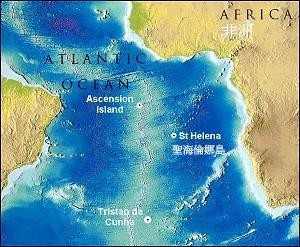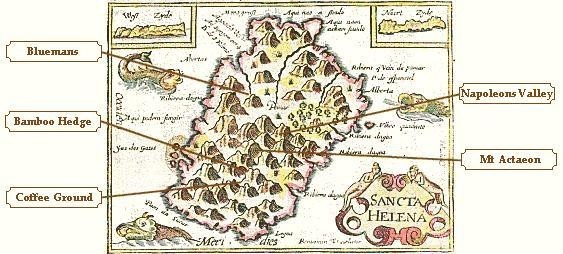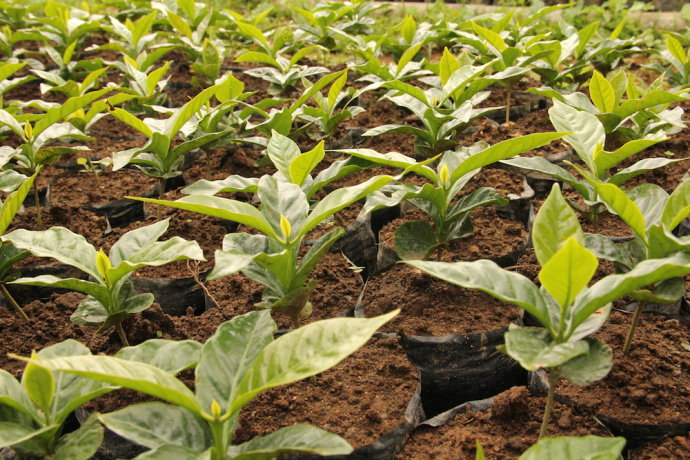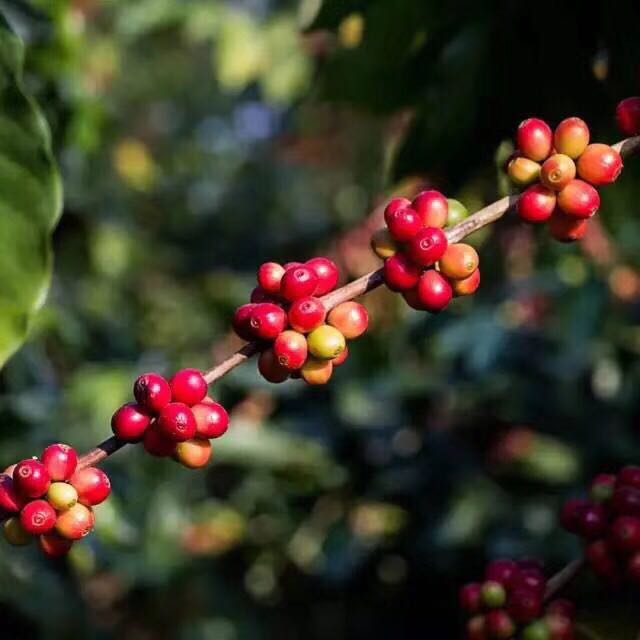About St. Helena Coffee, one of the most expensive coffee in the world, about $79 per pound
About St. Helena's Coffee.
St. Helena Coffee
Origin: British St. Helena Island, Atlantic Ocean
Price: about $79 per pound
St Helena Coffee
About St. Helena Coffee.
Located in the South Atlantic Ocean at latitude 16 °S and longitude 5 °45-# 39; west, St. Helena Island (The Island of St Helena) covers an area of 47 square miles along the path of the southeast trade wind. It is an island with a mountainous and subtropical climate. The remote location allows St. Helena to retain the purest ecological environment, the geology of the volcanic island also provides extremely fertile soil, coupled with the concept of organic cultivation and preservation of the original small bean seed, makes St. Helena Coffee unique.
About St. Helena Coffee.
(location of St. Helena Island)
St. Helena Coffee is unique not only in that it is pure Arabica beans, but also because it is the bourbon species of Arabica beans-Green Tipped Bourbon arabica, a bean that requires great care during harvest, washing and roasting to ensure that all its perfect qualities are preserved.
In 1994, David R. Henry founded the St. Helena Coffee Company (The Island of St Helena Coffee Company), which is dedicated to providing the perfect St. Helena Coffee raw and cooked beans. The beans sold by the St. Helena Island Coffee Company are grown by the company and operate independently of the St. Helena Island government.
About St. Helena Coffee.
David R. Henry
The history of St. Helena's coffee
< Source of seed >
On February 10, 1733, the East India Company (The East India Company) brought coffee seeds to St. Helena Island, and a ship from the port of Yemenmoka brought Green Tipped Bourbon Coffee seeds; these seeds began to be planted all over St. Helena and grew luxuriantly even though they were neglected.
About St. Helena Coffee.
When Napoleon was exiled on the island of St. Helena from 1815 to 1821, he praised St. Helena's coffee. St. Helena caffeine began to attract the world's attention and became popular in Paris.
About St. Helena Coffee.
(before Napoleon's exile on St. Helena Island was about to die, his adjutant Marshal Bertrand said: "seeing this once awesome man now begging for a spoonful of coffee makes my eyes red." ")
St. Helena Coffee has been highly rated one after another:
In 1839, Wm Burnie & Co, a London coffee merchant, said: "We introduce St. Helena Coffee to the industry, and its quality and flavor are consistently respected."
In 1845, St. Helena Coffee became the most expensive and unique coffee in the world at a price of 1 pence per pound.
In 1851, coffee grown at Bamboo Hedge Manor on St. Helena Island was favored by the judges at a coffee exhibition in London (The Great Exhibition).
About St. Helena Coffee.
(London Coffee Show 1851)
Although St. Helena coffee enjoyed high praise in the 19th century, the popularity did not continue, and even St. Helena Islanders seldom drank it afterwards.
When David R.Henry visited St. Helena Island in 1986, he was honored to taste the island's coffee with the Governor of St. Helena Island. This batch of coffee is produced in small quantities and is grown in Plantation House, the Governor's residence on St. Helena Island. Johnathan (below), a 260-year-old land turtle, also lives here, witnessing the origin and long history of St. Helena Coffee.
About St. Helena Coffee.
Johnathan
David R.Henry was so infatuated with St. Helena's coffee that he even wanted to live on the island, so he devoted himself to the production and promotion of St. Helena's coffee. David R.Henry spent eight years studying how coffee is produced and exported on St. Helena Island, during which time he flew painstakingly from London to St. Helena Island to assess the feasibility of developing the island's coffee industry. However, the most important step is to change Britain's role in the International Coffee Agreement (International Coffee Agreement) from an importer to an importer so that coffee can be exported from St. Helena Island, a British overseas territory.
Encounter with Endeavour Replica

Endeavour Replica
On October 16, 1996, an antique galleon named Endeavour Replica sailed around the world from Freemantle, Australia, and arrived on St. Helena Island on January 26, 1997 for a four-day stay. After the ship landed, David R. Henry asked Captain Chris Blake to transport St. Helena's coffee to Greenwich, London, in imitation of the 19th century transportation mode and route. The captain readily agreed to use ropes and pulleys to send sacks of coffee beans on board in the old-fashioned way. The crew happily visited St. Helena Island and posted the interesting trip on the website.
About St. Helena Coffee.
< (David ships St. Helena's coffee to London)
On January 30th, Endeavour Replica sailed to England with St. Helena Coffee. On March 25, 1997, Endeavour Replica arrived in London along the Thames River under the attention of a large number of media and the public.
About St. Helena Coffee.
(The Endeavour Replica sailing into the port of London, England)
David R. Henry personally went to the port to meet St. Helena Coffee and held a public relations event in Greenwich with Mitsubishi, Harrods and Whittard of Chelsea, customers who bought raw beans of St. Helena Coffee.
About St. Helena Coffee.
To celebrate Endeavour Replica's arrival in the UK, Wedgewood designed a unique ivy coffee can containing St. Helena coffee, presented to the Queen by two companies.
During the renovation of Napoleon Manor on St. Helena Island, some broken Wedgewood original ivy style tableware was found, which shows that during Napoleon's exile in St. Helena Island, the French regent asked Wedgewood to make ivy tea and coffee cutlery for Napoleon.
Endeavour Replica continued his voyage from Plymouth to North America on January 14, 1998, stopping in Tenerife, Spain, the British Virgin Islands and the Bahamas, and arrived at Palm Beach in western Florida on March 5, 1998.

Today's St. Helena Coffee
St Helena Coffee
The coffee produced by the St. Helena Coffee Company founded by David R.Henry is derived directly from the seeds that were brought to the island in 1733. After the manors on the island have been reclaimed, coffee trees and seedlings that produced coffee beans 150 years ago and exported to Britain have resumed production.
Over the past 10 years, coffee connoisseurs around the world have come to know St. Helena Coffee and are attracted by its uniqueness. With the successful development of new coffee estates, such as growing fruit and increasing production capacity, St. Helena Coffee is now proud to extend its manor coffee to the world, sharing it with coffee lovers.
Cultivation concept
St. Helena Island Coffee Company grows and handles coffee in a rigorous organic way and on its own basis. although it is remote and has not yet obtained official certification for organic cultivation, it is already in progress. St. Helena uses only natural fertilizers and livestock droppings are not used as fertilizers because feed or artificial farming processes may make their faeces contain non-organic matter. St. Helena is lucky to have plenty of bird droppings, which are collected from coastal rocks as natural fertilizer, dried and sprinkled under coffee trees at the beginning of the rainy season. St. Helena uses natural spring water from the mountains to wash and treat coffee beans.
David R. Henry implements integrated planting on the island, a concept that includes planting plants endemic to the island, such as the endangered St. Helena ebony and St. Helena kale trees, which provide shade for coffee trees to grow on the outskirts of the manor. Under the demonstration of David R. Henry, it is expected that the coffee industry of St. Helena Island will coexist peacefully with its ecological assets.
even bargain
Coffee and tea, two labour-intensive industries, are often criticized for labour exploitation, a phenomenon that does not happen at the St. Helena Coffee Company. Compared with other coffee producing areas in the world, St. Helena Island is lucky to have no social problems such as poverty and homelessness. under the British government, islanders enjoy health insurance subsidies and access to education.
Most of the residents of St. Helena choose to work overseas, making it difficult to find agricultural labor on the island. To encourage diligence and positive work attitude, St. Helena Coffee receives rewards for good performance, such as salary increases, interest-free loans, use of transportation and agricultural equipment. Employees of St. Helena Island Coffee Company are proud to share the fruits of success with the company, promote St. Helena's export industry, promote agricultural growth in St. Helena, and contribute to future self-reliance.
Quality control
The coffee produced by St. Helena Island Coffee Company has undergone strict quality control, especially the output is low, and each coffee bean can be taken care of more attentively. During the harvest season, each estate is harvested once a week to ensure the best quality coffee fruit. Under the self-management of David R. Henry, St. Helena Coffee enjoys close and careful control in every production process, a small estate and loyal staff, which gives St. Helena Coffee an advantage that other large-scale coffee industries lack. Whether it is picking raw beans, washing, drying, or shelling the fruit, it is done to the highest standards, and St. Helena caffeine continues to enjoy a high rating among coffee gluttons around the world.
Introduction to Coffee Manor
The estate is located above Napoleon's graveyard, at the front of the Geranium Valley. Napoleon often came here to seek peace of mind and asked to be buried here. His adjutant Marshall Bertrand and his wife also lived on the estate. During the preparation of the Napoleon's Valley manor, some handicrafts such as Wedgewood porcelain, wine bottles and a row of stone steps leading to Napoleon's tombstone were unearthed.
This estate is the main producing area of St. Helena's coffee. Although it has been abandoned for a long time, after continuous land preparation and reclamation, it has been able to produce better quality, stronger and fuller coffee beans.
This is the private estate of the founder of St. Helena Island Coffee Company and the first of the new estates to be developed; Bluemans is located on a hilltop in the western half of St. Helena Island, overlooking almost the entire island.
Plant coffee saplings on Bluemans Manor)
Located 2200 feet above sea level, Mt Actaeon, together with G.W. Alexander and Coffee Ground Manor, overlooks the beauty of Sandy Bay Crater.
The G.W. Alexander Manor, located in Bamboo Hedge, is the oldest estate on the island and may have been planted since the early 1730s. In 1839, London businessman Wm. Burnie & Co got the coffee from the estate and later participated in the 1851 exhibition (The Great Exhibition), which won high praise. After large-scale land preparation, the productivity of the manor has increased, combining the old and new generations of coffee trees.
< The G.W. Alexander Coffee Manor >
St. Helena Green Tipped Bourbon coffee has a glossy surface after rigorous standard washing, and after moderate baking, it has a bright, soft acidity and a strong aroma, with citrus fruit aromas and caramel flavours from the leaf variety.
About St. Helena Island
The Island of St Helena
About St. Helena Coffee.
On May 21, 1502, the Portuguese Admiral Joao da Nova discovered the island of St. Helena. He landed in present-day Jamestown and built a chapel. For more than 80 years, the Portuguese did not make the island public, but used it as a replenishment site for their East Indian fleet.
About St. Helena Coffee.
In 1588, the captain of HMS Desire, an Englishman, Thomas Cavendish, also discovered St. Helena on a voyage around the world, which was often visited by British and Dutch ships. When the Dutch tried to take St. Helena Island for themselves in 1633, the British East India Company began to garrison and established a permanent colony in 1659. In 1673, the Dutch occupied St. Helena Island, but it was retaken by the British four months later, and the East India Company was granted the right to operate the island until it was directly administered by the British royal family in 1834. On October 15, 1815, the defeated Napoleon was exiled to St. Helena Island, where he spent the rest of his life in Longwood House and died on May 5, 1821. About St. Helena Coffee.
St. Helena Island is a British overseas colony, the official language is English, with a population of about 5000, mainly of British, African and Chinese origin. The nearest land to St. Helena Island is Ascension Island, about 703 miles north-west, and the nearest continental port is Cape Town, South Africa, about 1700 miles southeast of St. Helena Island. St. Helena Island is one of the most remote lands in the world. There is no airport on the island, and the only way to get to and from the island is by Royal Mail Ship St Helena, a fleet operated by Britain.

Important Notice :
前街咖啡 FrontStreet Coffee has moved to new addredd:
FrontStreet Coffee Address: 315,Donghua East Road,GuangZhou
Tel:020 38364473
- Prev

The list of the most expensive coffee in the world is recommended by coffee bean brands.
NO1 name: 90 + Prospect Ruby Summer Origin: Panama Price: about $1000 per pound [Prospect Ruby Coffee] claims to be the best coffee in the world
- Next

Growing bourbon pointed coffee on Reunion Island is a variety of gourmet Arabica coffee.
Bourbon pointed coffee is a variety of gourmet Arabica coffee the locally produced bourbon pointed coffee (scientific name Laurina) is a variety of gourmet Arabica coffee. Grows on a hillside with an elevation of 1499 feet above sea level. It has a long history of growing in Reunion. In the 18th and 19th centuries, bourbon pointed coffee was still very delicate, produced very low, scarce and expensive, so it was expensive. Method
Related
- Detailed explanation of Jadeite planting Land in Panamanian Jadeite Manor introduction to the grading system of Jadeite competitive bidding, Red bid, Green bid and Rose Summer
- Story of Coffee planting in Brenka region of Costa Rica Stonehenge Manor anaerobic heavy honey treatment of flavor mouth
- What's on the barrel of Blue Mountain Coffee beans?
- Can American coffee also pull flowers? How to use hot American style to pull out a good-looking pattern?
- Can you make a cold extract with coffee beans? What is the right proportion for cold-extracted coffee formula?
- Indonesian PWN Gold Mandrine Coffee Origin Features Flavor How to Chong? Mandolin coffee is American.
- A brief introduction to the flavor characteristics of Brazilian yellow bourbon coffee beans
- What is the effect of different water quality on the flavor of cold-extracted coffee? What kind of water is best for brewing coffee?
- Why do you think of Rose Summer whenever you mention Panamanian coffee?
- Introduction to the characteristics of authentic blue mountain coffee bean producing areas? What is the CIB Coffee Authority in Jamaica?

